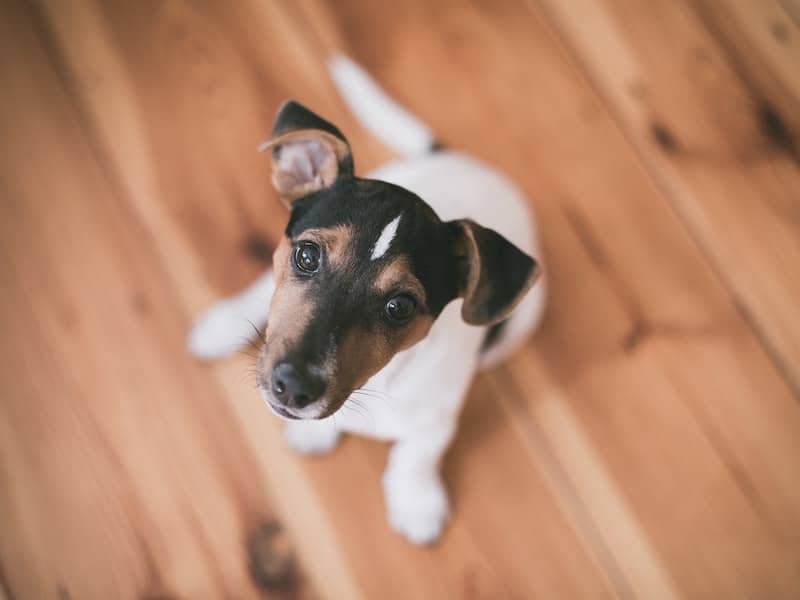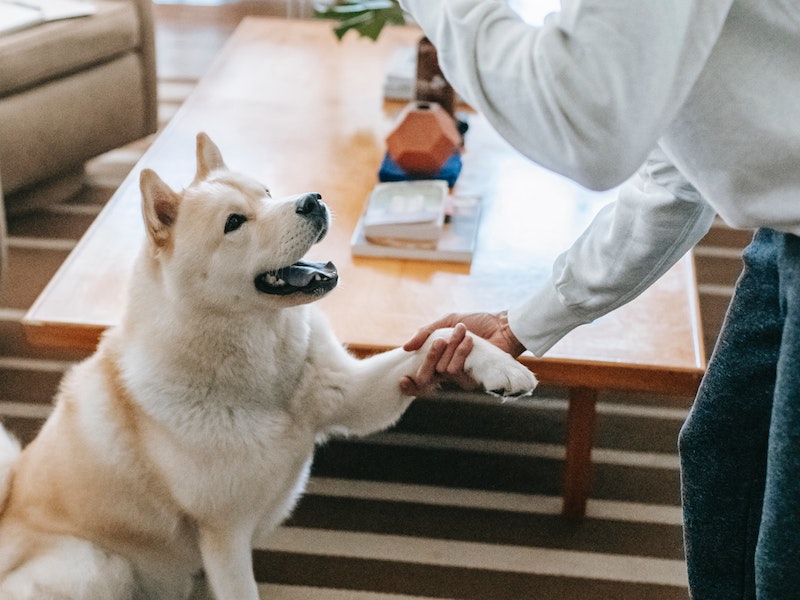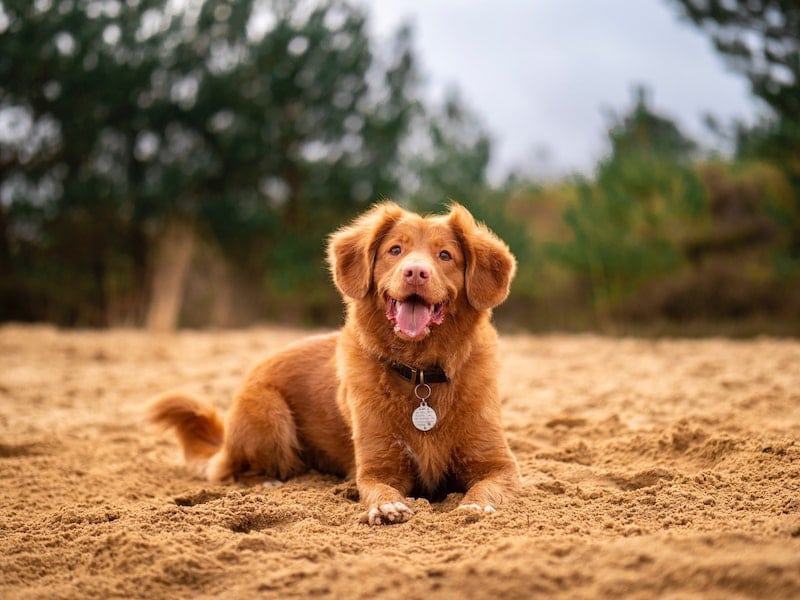
Learning commands is a great activity for both dogs and their parents that can help build a great relationship between them. It also brings a lot of satisfaction and joy. You can train a dog of any breed and at any age. However, it is recommended to start training as early as possible. Puppies are the fastest and most eager to learn new things, which makes training much easier.
Every dog is different, so training should be adjusted individually to the dog’s needs and abilities. Make sure to choose the right level of training for your pet. If you start demanding too many difficult things from your dog, they may become frustrated and discouraged for further training.
Here is our list of six easy commands for dog training beginners:
1. Sit

“Sit” is one of the basic commands that you should teach your pet. Most pets master it relatively quickly and even a very young puppy can be taught to sit on command. Both puppies and older dogs have problems with staying in this position for a longer time. This command is very useful in many situations when you need to control your pet’s emotions.
How to start training?
- Take a dog treat in your hand.
- Raise your hand with the treat above your dog’s head (just above their nose) and move it backward.
- The dog focusing their sight on the treat should automatically sit.
- When the dog sits, praise and reward them.
Learning this command is not complicated, but remember to practice systematically and gradually increase the time your dog stays in this position. It is also worth adding a release cue so it will be a clear signal for the dog to get up.
2. Touch
The command “Touch” is a super base for many other exercises. The goal of this exercise is for the dog to touch your hand with their nose. Dogs usually very quickly understand what is expected from them. Thanks to this command, you can easily guide the dog to different places or a specific position (e.g. heel, place). In fact, you can achieve many other things and tricks with the touch cue. For example, you can teach your dog to close the door or turn off the light.
How to do it?
- Show the dog an open hand from behind your back. If the dog is not interested, hide it and show it again.
- If your pup is interested in your hand and at least smells it, praise them and give a treat (a clicker is very useful in this exercise as it is more precise than a verbal cue).
- With time, require the dog to press the hand with their nose, not just sniff it.
- Gradually you can make this exercise more difficult and require the dog to follow the moving hand, touch it from a distance, etc.
* If the dog is not interested in the hand at all, you can start by putting a treat between the fingers.
3. Give a Paw

“Give a paw” is more of a trick than a command, nevertheless it is very effective. Learning tricks, as well as commands, positively influence the dog-human relationship. It is fun to diversify training with such exercises so that both sides have fun.
How to start?
- Take an interesting treat in your hand and close your hand.
- When the dog tries to reach for it, catch the moment when they start to nudge your hand with their paw.
- At this point, praise and reward your pup.
- When the dog understands what is going on, try to keep your hand open.
PRO TIP: Remember to name the paw commands differently, e.g. “left” and “right”, so that your dog can distinguish between them when you introduce the second paw command.
4. High-five
“High-five” is based on the same concept as the “Give a paw” trick. If your dog has already learned the previous command, it will be much easier for you to move on to high-five. This exercise looks attractive and you can demonstrate it in front of family and friends.
How to teach it?
- Hold a treat in your hand, close your palm in a fist and raise your hand higher.
- When your dog starts to rub his paw on your hand, praise them and reward them with the treat.
- Gradually eliminate the treats and keep your empty hand in the air, waiting for your dog’s reaction.
5. Lie down

It is best to start teaching the command “Stay” at a time when your dog can already do “Sit”. To begin with, it will simply be easier to guide your dog to lie down from a sit. The static commands “Stay” and “Sit” are very important in learning basic obedience, so they should be introduced as early as possible.
How to start learning?
- Lead your dog to the sitting position.
- Take your dog’s favorite treat in your hand and put it under their nose, then slowly move your hand with the treat towards the ground.
- Your pup should follow the treat and move to the lying position.
- At this point, praise and reward your dog.
PRO TIP: Make sure to give the reward when the dog is in the correct position and not, for example, when they stand up.
6. Spin
Spin is a fun trick for beginners. Dogs learn this exercise fairly quickly. It is not complicated, though it looks spectacular.
How to teach this to your dog?
- Prepare a tasty treat.
- When the dog is standing, put the treat under their nose, and slowly, so that the dog follows it, make a circle around their own body with your hand. The dog should turn 360 degrees while following the treat.
- Gradually remove treats and only show the gesture with your hand until you reach the stage where the gesture alone or verbal command will suffice.
PRO TIP: Over time, you can teach your dog to make a turn both ways. However, remember to call these commands differently, e.g. “Spin” and “Circle”.
Summary
To be as effective as possible, training should be based on regularity. Systematic work with your dog, even 5 minutes a day, gives much better results than a half-hour session once a week. Remember that training should be a pleasure, both for you and your pet.
When practicing with your dog, remember these basic rules:
- Training should be short and interesting so that your pet does not get bored and discouraged.
- Always finish the training session with your dog’s success.
- Do not let your dog finish the training on their own, e.g. by walking away (your dog will quickly understand that they can decide when the training is over and will take advantage of it). If you see that your dog is bored, call them to you, give one last command and end the training.
- Don’t get upset if your dog doesn’t perform well right away. Your dog will sense your feelings and the training will go worse. If you are in a bad mood, skip the training that day.
- Adjust rewards according to the difficulty of the exercise. The more difficult the exercise (e.g. with more distractions), the better (tastier!) the reward.
You can teach your dog all the commands described above using the Dogo app. With visual and video instructions, training will be pleasant and successful.
Author’s Bio
Marcelina Gajdzik is a dog trainer from Poland. She graduated from the Polish Academy of Zoopsychology and Animal Therapy. She completed courses in dog psychology and behavioral studies. She wishes to constantly deepen her knowledge in order to help others create a strong, happy bond with their pets. She is a trainer at the Dogo app.
Looking to learn more dog training tips?
- Dog Leash Training: Pleasant Walks With Your Puppy
- How To Crate Train Your Puppy or Dog While You’re At Home
- The Ultimate Training Guide With Pet Releaf’s Soft Chew Edibites




